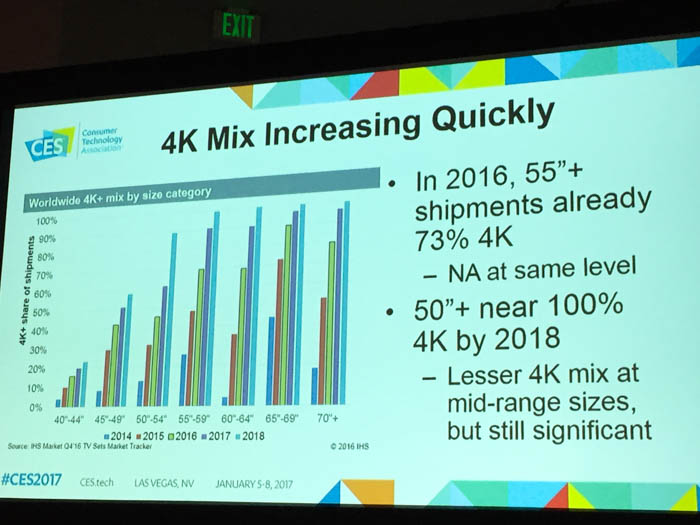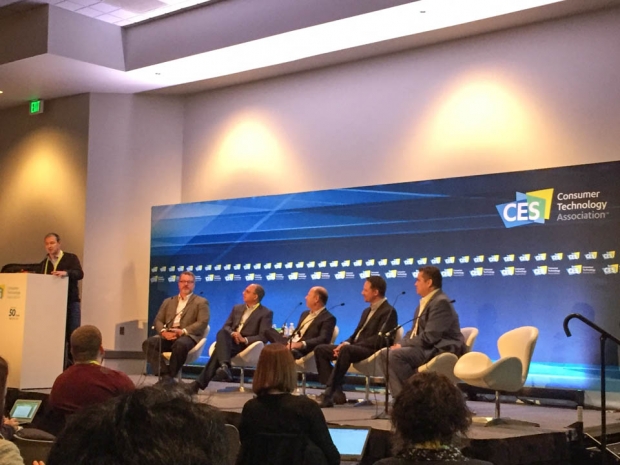The panel was co-hosted by IHS Markit, Amazon Video, Consumer Reports, Fox Sports, and Warner Brothers Home Entertainment, giving perspectives from both the IP side and the content side of matters and how breakthroughs such as HDR and wide color gamut are contributing to higher adoption than a mere bump in display resolution.
Industry’s next goal: solving HDR standard confusion
Over the course of 2016, there was a 300 percent increase in viewing 4K content, according to Amazon Video’s BA Winston. “When we were building HDR in 2015, color grading was not available and there was no unified standard,” referring to the introduction of both HDR10 and Dolby Vision formats earlier that year. He says one of the main goals for 2017 is solving the confusion among consumers regarding different HDR formats.
The latest research from IHS Markit expects the transition from 1080p to 4K to exceed much more quickly at sizes greater than 50 inches, with nearly 100 percent of television sets in this size range using 4K panels by 2018. The group says that 4K premiums are falling rather quickly, giving consumers more incentive to adopt the newer resolution platform, but still failing to address the confusion from having multiple HDR standards (HDR10, Dolby Vision, HLG, Technicolor’s Advanced HDR), and which devices are actually needed for proper playback.
10 million native HDR sets this year
All the panelists admitted that HDR is a much more significant “value-adding technology” than the transition to higher 4K resolutions, as most people usually don’t notice a difference in pixel density when sitting away at eight to 10 feet. The second feature that consumers have reacted to is wide color gamut (WCG), or an increase in color accuracy and precision using larger color spaces.
In 2017, the industry expects there will be 10 million HDR-capable sets, but 14 million with wide color gamut. By the following year, there will still be a larger increase in the number of “HDR-compatible” displays shipped (over 60 million), however, verses those with native HDR capabilities (under 20 million).
Why doesn’t 1080p have HDR?
One of the more interesting questions raised during the conversation is the reason why the more broadly adopted 1080p Full HD format does not support the HDR standard. The short answer is that there is a “tiered strategy” to introducing products into the consumer market. Based on product strategy alone, most vendors are marketing 4K as a “premium” standard with premium features, and this is how they want consumers to react to the trend as well. By including a premium feature such as HDR into a non-premium resolution platform, consumers are not expected to react as sharply and the profit margins are not as beneficial to vendors than by marketing it with the emerging standard.
HDR formats continue to be dependent on individual filmmakers
On the positive side, however, the number of HDR titles is expected to triple in 2017 from its reach of just over 100 titles by the end of last year. Regarding support for one format or the other, Warner Bros President Ron Sanders says “it’s the right thing for us to support both technologies, but it’s more complex behind the scenes because the pipelines are different”. He emphasized that industry executives want to push brightness levels to emphasize them to consumers, while filmmakers may be a bit more conservative depending on their particular filming style.
Content delivery is currently a complex situation
In terms of reaching critical mass, Michael Davies from Fox Sports says that the keys to 4K proper delivery relies on distributors, TV networks and back-end providers, as the new emerging platform is still a costly upgrade. With the industry quickly showing signs of the first 8K field tests, many video providers have been hesitant to upgrade their end-to-end broadcast setups in an industry fueled by squeezing out higher profit margins at the expense of valuable investment reserves. However, he was quick to admit that there are some problems that 4K with HDR can “solve quite readily”. He used the example of the typical lighting situations in a football stadium, where half of the audience and field might be covered by shadows or cloud cover while the other half is in the sun. With HDR, scene brightness can be more easily compensated to deliver content value immediately noticeable to consumers.
He says that Fox recently tested an Astro 8K camera at the World Series in late October, and the company was impressed at “how plug-and-play ready the technology was”. Last year’s Super Bowl was filmed in 8K resolution using six cameras from Japanese broadcaster NHK, he says there will again be a few 8K cameras at this year’s Super Bowl, and significantly more 4K cameras than ever before.
The road to 8K consists of a longer runway
As the Ultra HD broadcast situation stands for sports at least, most content is not delivered entirely in 4K but is rather composed of a mixture of 1080p sources, and the situation on HDR has yet to be simplified. In November, Mediapro announced that they would be transmitting the Spanish Football League worldwide in HDR using the Hybrid Log Gamma (HLG) format, while the BBC and NHK in Japan have been working on the royalty-free standard since 2014 for use in live television broadcasts starting with UHD-1 Phase II later this year.
Regarding the application of 8K filming over recent 4K deployments in the sports industry, Davies says “is the perfect coach tool as a zoom function on every player”.




